Influence of MnO2-Birnessite Microstructure on the Electrochemical Performance of Aqueous Zinc Ion Batteries
Abstract
:1. Introduction
2. Materials and Methods
2.1. Synthesis of Materials
2.2. Characterization Techniques
3. Results and Discussion
3.1. Materials Characterization
3.2. Electrochemical Behaviour
4. Conclusions
Supplementary Materials
Author Contributions
Funding
Institutional Review Board Statement
Informed Consent Statement
Data Availability Statement
Acknowledgments
Conflicts of Interest
References
- Dehghani-Sanij, A.R.; Tharumalingam, E.; Dusseault, M.B.; Fraser, R. Study of energy storage systems and environmental challenges of batteries. Renew. Sustain. Energy Rev. 2019, 104, 192–208. [Google Scholar] [CrossRef]
- Chao, D.; Zhou, W.; Xie, F.; Ye, C.; Li, H.; Jaroniec, M.; Qiao, S.-Z. Roadmap for advanced aqueous batteries: From design of materials to applications. Sci. Adv. 2020, 6, eaba4098. [Google Scholar] [CrossRef] [PubMed]
- Alfaruqi, M.H.; Mathew, V.; Gim, J.; Kim, S.; Song, J.; Baboo, J.P.; Choi, S.H.; Kim, J. Electrochemically Induced Structural Transformation in a γ-MnO2 Cathode of a High Capacity Zinc-Ion Battery System. Chem. Mater. 2015, 27, 3609–3620. [Google Scholar] [CrossRef]
- Blanc, L.E.; Kundu, D.; Nazar, L.F. Scientific Challenges for the Implementation of Zn-Ion Batteries. Joule 2020, 4, 771–799. [Google Scholar] [CrossRef]
- Li, B.; Zhang, X.; Wang, T.; He, Z.; Lu, B.; Liang, S.; Zhou, J. Interfacial Engineering Strategy for High-Performance Zn Metal Anodes. Nano-Micro Lett. 2022, 14, 6. [Google Scholar] [CrossRef]
- Tang, F.; Gao, J.; Ruan, Q.; Wu, X.; Wu, X.; Zhang, T.; Liu, Z.; Xiang, Y.; He, Z.; Wu, X. Graphene-Wrapped MnO/C Composites by MOFs-Derived as Cathode Material for Aqueous Zinc ion Batteries. Electrochim. Acta 2020, 353, 136570. [Google Scholar] [CrossRef]
- Canepa, P.; Gautam, G.S.; Hannah, D.C.; Malik, R.; Liu, M.; Gallagher, K.G.; Persson, K.A.; Ceder, G. Odyssey of Multivalent Cathode Materials: Open Questions and Future Challenges. Chem. Rev. 2017, 117, 4287–4341. [Google Scholar] [CrossRef]
- Rietveld, H.M. A profile refinement method for nuclear and magnetic structures. J. Appl. Crystallogr. 1969, 2, 65. [Google Scholar] [CrossRef]
- Rodriguez-Carvajal, J. Recent advances in magnetic structure determination by neutron powder diffraction. Phys. B Condens. Matter 1993, 192, 55. [Google Scholar] [CrossRef]
- Gaillot, A.-C.; Flot, D.; Drits, V.A.; Manceau, A.; Burghammer, M.; Lanson, B. Structure of Synthetic K-rich Birnessite Obtained by High-Temperature Decomposition of KMnO4. I. Two-Layer Polytype from 800 °C Experiment. Chem. Mater. 2003, 15, 4666–4678. [Google Scholar] [CrossRef] [Green Version]
- Gaillot, A.-C.; Drits, V.A.; Plancüon, A.; Lanson, B. Structure of Synthetic K-Rich Birnessites Obtained by High-Temperature Decomposition of KMnO4. 2. Phase and Structural Heterogeneities. Chem. Mater. 2004, 16, 1890–1905. [Google Scholar] [CrossRef] [Green Version]
- Arias, N.P.; Becerra, M.E.; Giraldo, O. Structural and Electrical Studies for Birnessite-Type Materials Synthesized by Solid-State Reactions. Nanomaterials 2019, 9, 1156. [Google Scholar] [CrossRef] [PubMed] [Green Version]
- Becerra, M.E.; Arias, N.P.; Giraldo, O.H.; López, F.E.; Gómez, M.J.I.; Bueno, A. Soot combustion manganese catalysts prepared by thermal decomposition of KMnO4. Appl. Catal. B Environ. 2011, 102, 260–266. [Google Scholar] [CrossRef]
- Oku, M.; Hirokawa, K.; Ikeda, S. X-ray photoelectron spectroscopy of manganese-Oxygen systems. J. Electron. Spectrosc. Relat. Phenom. 1975, 7, 465–473. [Google Scholar] [CrossRef]
- Huynh, M.; Shi, C.; Billinge, S.J.L.; Nocera, D.G. Nature of Activated Manganese Oxide for Oxygen Evolution. J. Am. Chem. Soc. 2015, 137, 14887–14904. [Google Scholar] [CrossRef]
- Beyreuther, E.; Grafström, S.; Eng, L.M.; Thiele, C.; Dörr, K. XPS investigation of Mn valence in lanthanum manganite thin films under variation of oxygen content. Phys. Rev. B 2006, 73, 155425. [Google Scholar] [CrossRef]
- Cao, R.; Li, L.; Zhang, P.; Gao, L.; Rong, S. Regulating oxygen vacancies in ultrathin δ-MnO2 nanosheets with superior activity for gaseous ozone decomposition. Environ. Sci. Nano 2021, 8, 1628–1641. [Google Scholar] [CrossRef]
- Zhang, W.; Zhai, X.; Zhang, Y.; Wei, H.; Ma, J.; Wang, J.; Liang, L.; Liu, Y.; Wang, G.; Ren, F.; et al. Application of Manganese-Based Materials in Aqueous Rechargeable Zinc-Ion Batteries. Front. Energy Res. 2020, 8, 195. [Google Scholar] [CrossRef]
- Hao, J.; Mou, J.; Zhang, J.; Dong, L.; Liu, W.; Xu, C.; Kang, F. Electrochemically induced spinel-layered phase transition of Mn3O4 in high performance neutral aqueous rechargeable zinc battery. Electrochim. Acta 2018, 259, 170. [Google Scholar] [CrossRef]
- Chen, L.; Yang, Z.; Cui, F.; Meng, J.; Jiang, Y.; Long, J.; Zeng, X. Ultrathin MnO2 nanoflakes grown on N-doped hollow carbon spheres for high-performance aqueous zinc ion batteries. Mater. Chem. Front. 2020, 4, 213. [Google Scholar]
- Yang, S.; Zhang, M.; Wu, X.; Wu, X.; Li, F.Z.Y.; Duan, S.; Fan, D.; Yang, Y.; Wu, X. The excellent electrochemical performances of ZnMn2O4/Mn2O3: The composite cathode material for potential aqueous zinc ion batteries. J. Electroanal. Chem. 2019, 832, 69. [Google Scholar] [CrossRef]
- Fan, X.; Zhu, Y.; Luo, C.; Suo, L.; Lin, Y.; Gao, T.; Xu, K.; Wang, C. Pomegranate-Structured Conversion-Reaction Cathode with a Built-in Li Source for High-Energy Li-Ion Batteries. ACS Nano 2016, 10, 5567. [Google Scholar] [CrossRef] [PubMed]
- Álvarez-Serrano, I.; Almodóvar, P.; Giraldo, D.A.; Llopis, F.; Solsona, B.; López, M.L. Stable Manganese-Oxide Composites as Cathodes for Zn-Ion Batteries: Interface Activation from In Situ Layer Electrochemical Deposition under 2 V. Adv. Mater. Interfaces 2021, 2101924. [Google Scholar] [CrossRef]
- Qiu, C.; Zhu, X.; Xue, L.; Ni, M.; Zhao, Y.; Liu, B.; Xia, H. The function of Mn2+ additive in aqueous electrolyte for Zn/δ-MnO2 battery. Electrochim. Acta 2020, 351, 136445. [Google Scholar] [CrossRef]
- Yang, J.; Cao, J.; Peng, Y.; Yang, W.; Barg, S.; Liu, Z.; Kinloch, I.A.; Bissett, M.A.; Dryfe, R.A.W. Unravelling the Mechanism of Rechargeable Aqueous Zn–MnO2 Batteries: Implementation of Charging Process by Electrodeposition of MnO2. ChemSusChem 2020, 13, 4103–4110. [Google Scholar] [CrossRef] [PubMed]
- Alfaruqi, M.H.; Islam, S.; Putro, D.Y.; Mathew, V.; Kim, S.; Jo, J.; Kim, S.; Sun, Y.-K.; Kim, K.; Kim, J. Structural transformation andelectrochemical study of layered MnO2 in rechargeable aqueous zinc-ion battery. Electrochim. Acta 2018, 276, 1–11. [Google Scholar] [CrossRef]

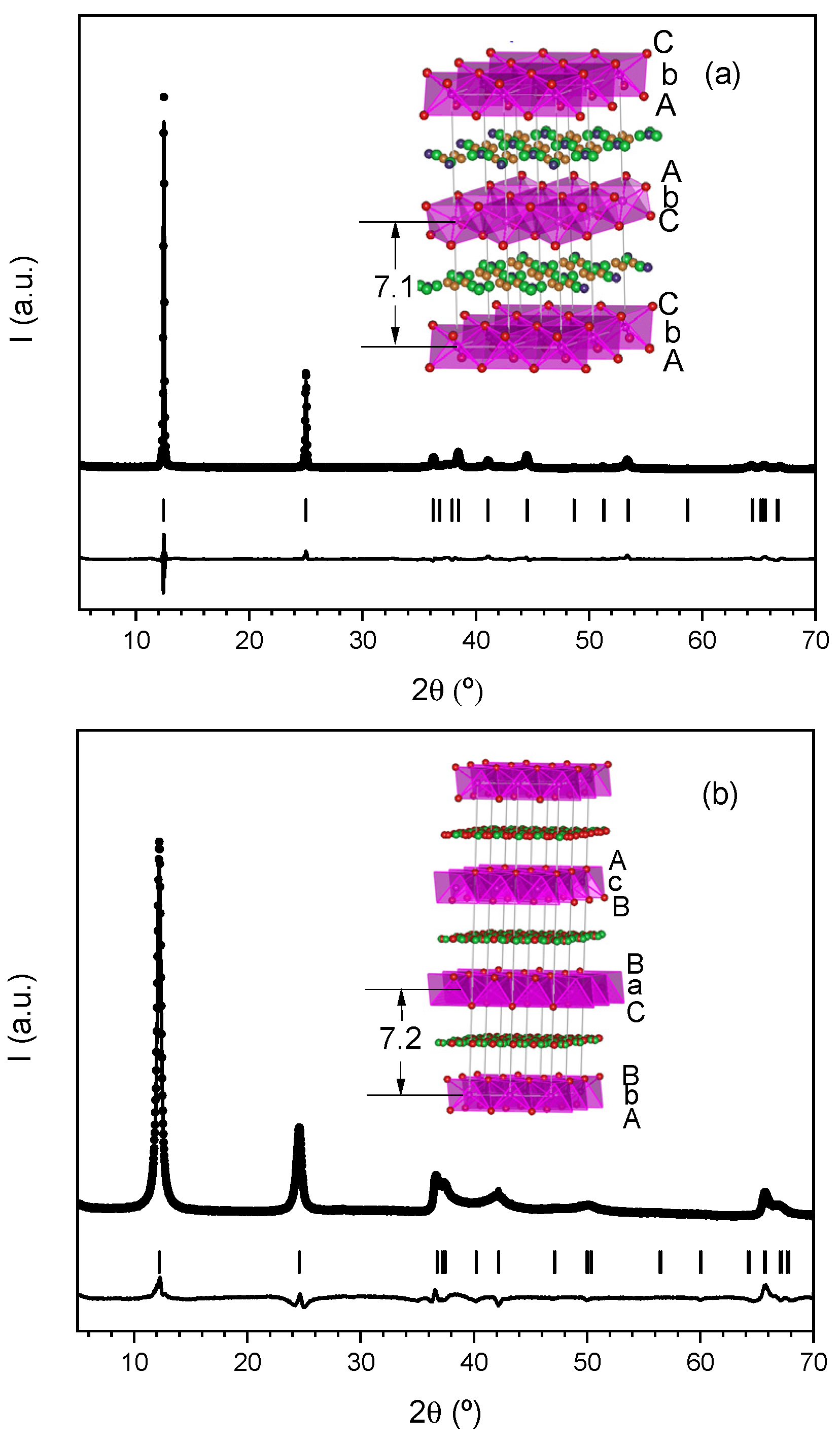
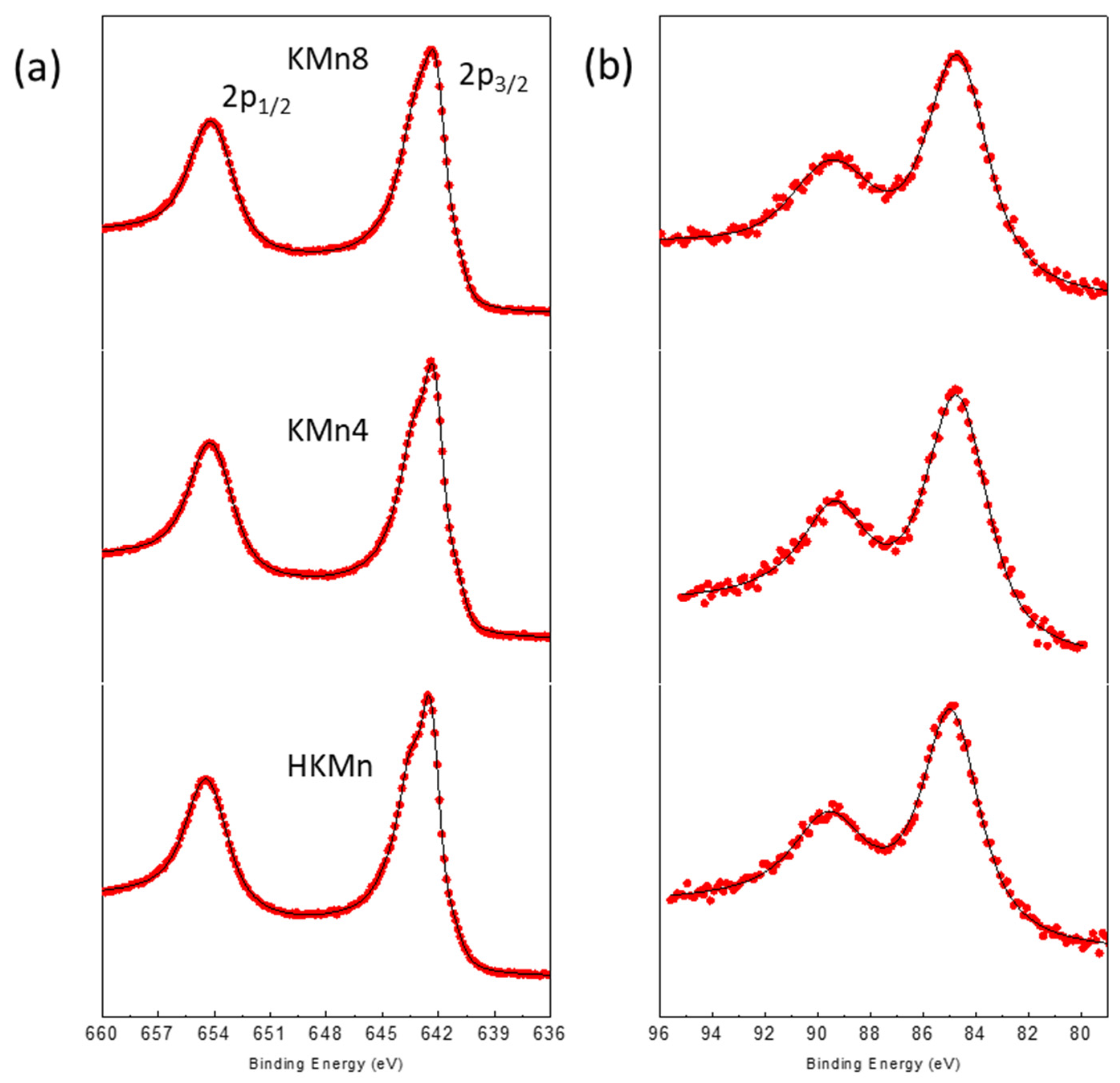
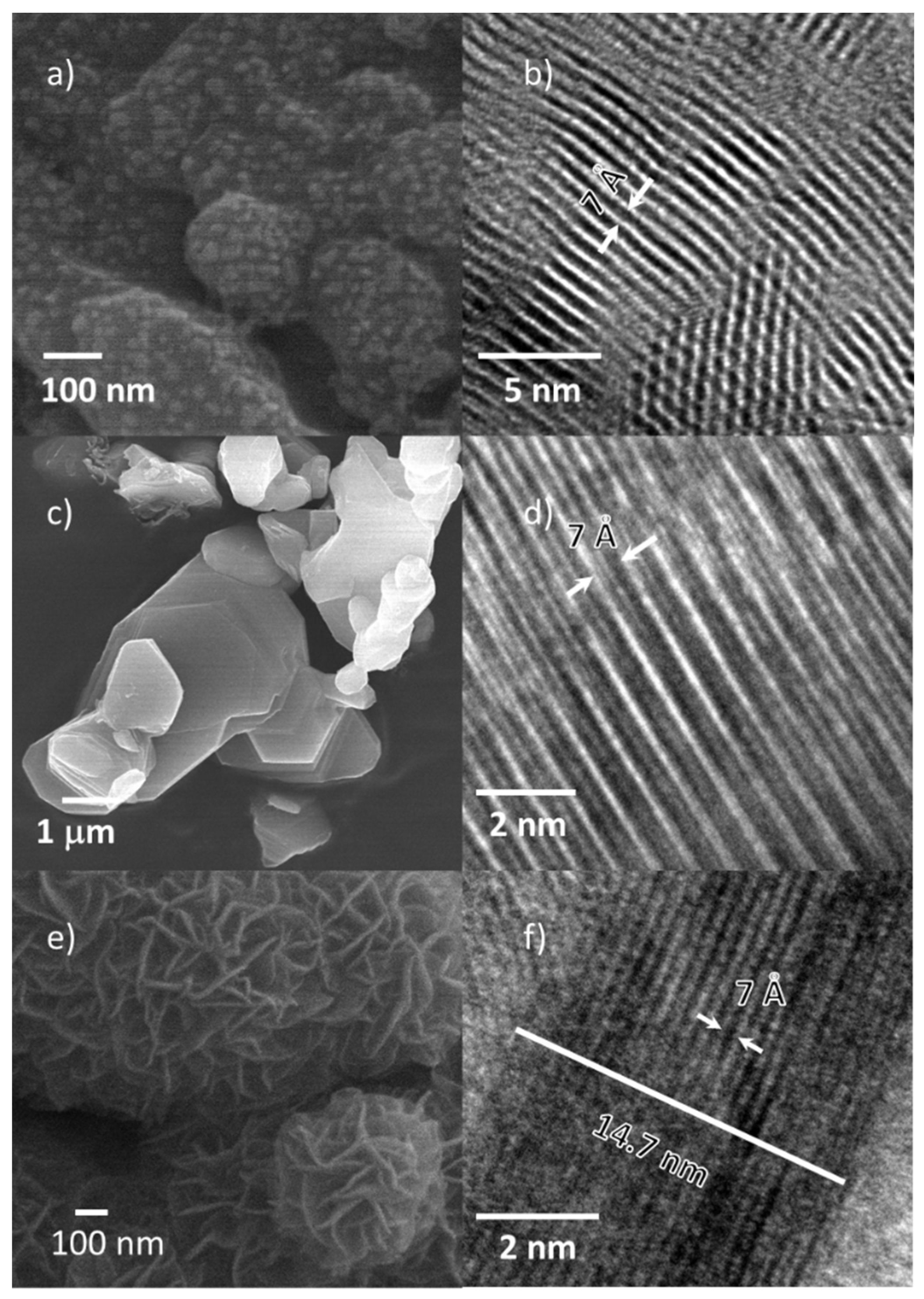


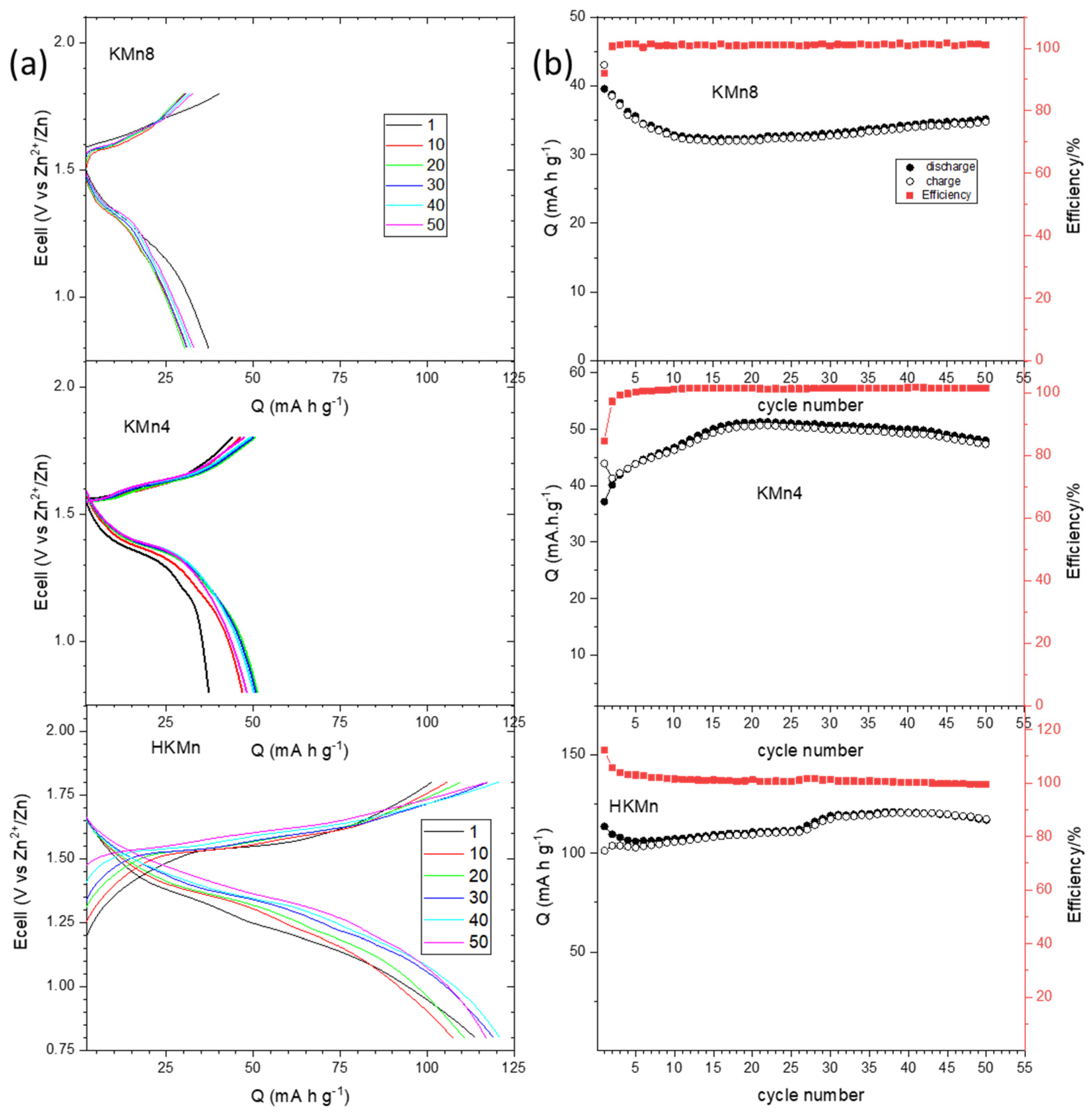
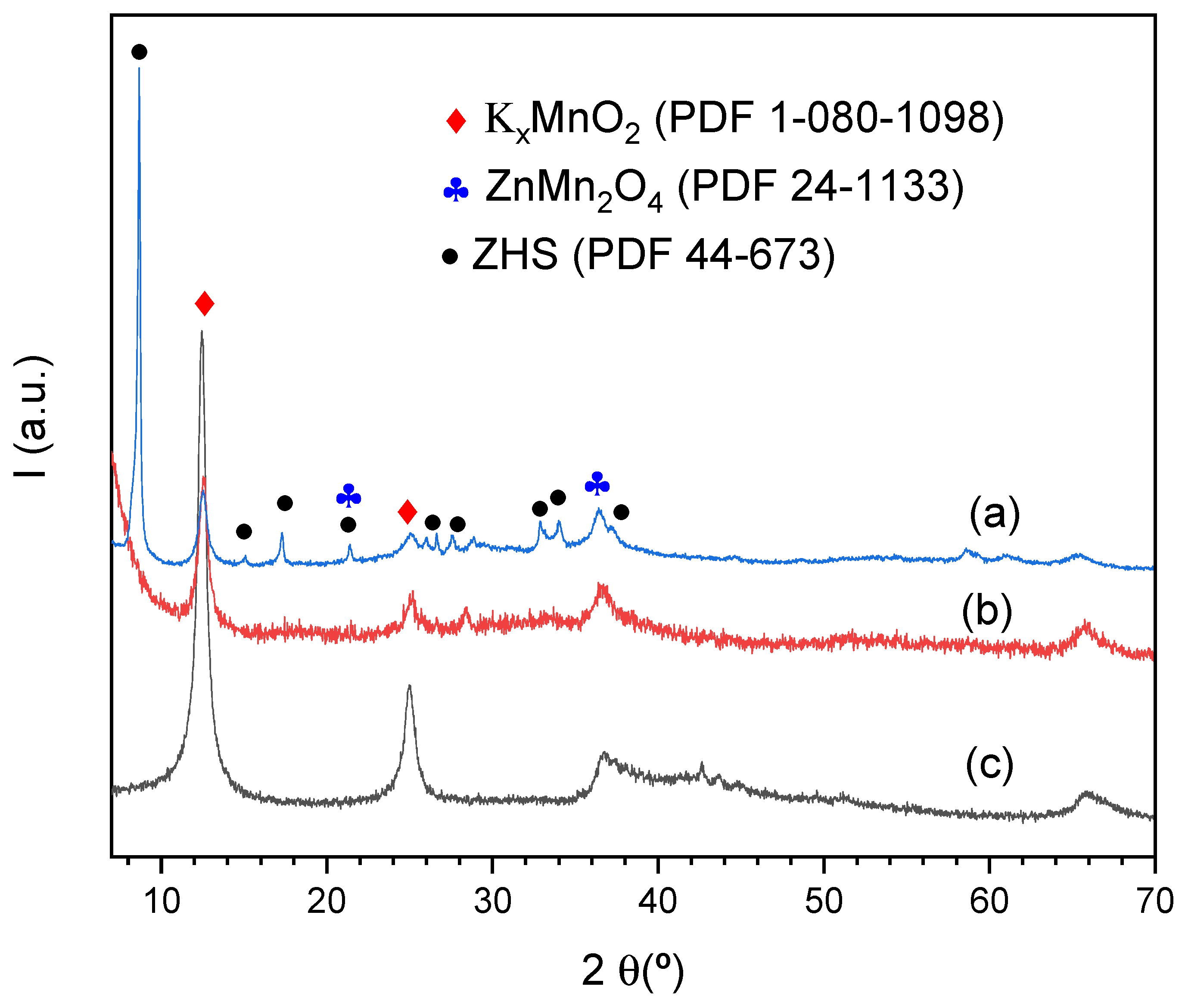
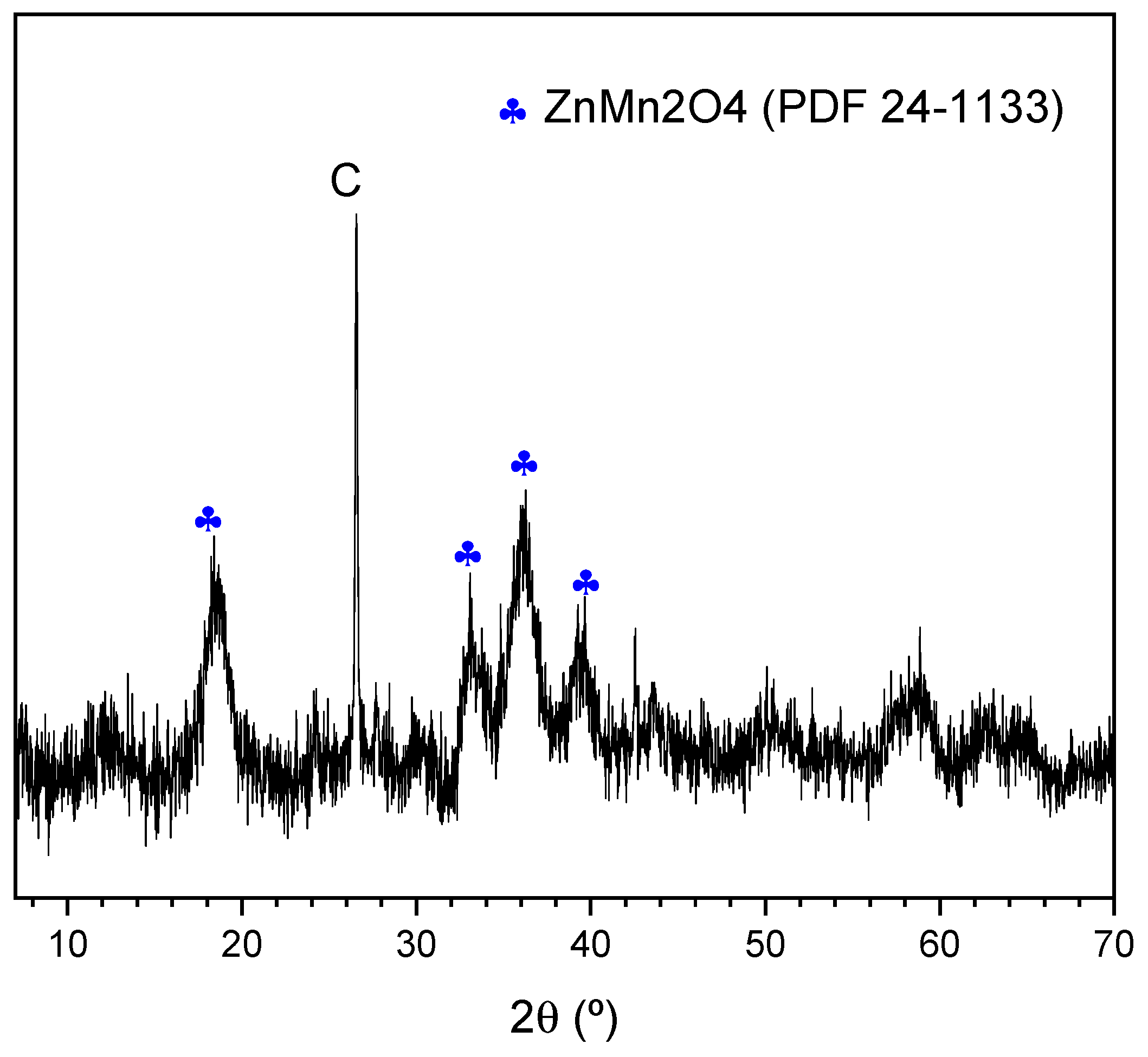
| Phase | KMn8 | HKMn |
|---|---|---|
| Space group | P 63/mmc | R -3m |
| a (Å) | 2.864 (5) | 2.846 (9) |
| c (Å) | 14.274 (2) | 21.751 (6) |
| Rp | 19.3 | 15.3 |
| Rwp | 18.2 | 16.1 |
| RB | 9.1 | 4.7 |
| Sample | Mn 2p | Mn 3s | |||||
|---|---|---|---|---|---|---|---|
| 2p1/2 | 2p3/2 | Δ(2p1/2–2p3/2) | 3s(1) | 3s(2) | Δ(3s(1)–3s(2)) | υMn | |
| KMn4 | 654.2 | 642.4 | 11.8 | 89.4 | 84.7 | 4.7 | 3.8 |
| KMn8 | 654.2 | 642.3 | 11.9 | 89.3 | 84.7 | 4.6 | 3.6 |
| HKMn | 654.4 | 642.6 | 11.8 | 89.6 | 84.9 | 4.7 | 3.8 |
Publisher’s Note: MDPI stays neutral with regard to jurisdictional claims in published maps and institutional affiliations. |
© 2022 by the authors. Licensee MDPI, Basel, Switzerland. This article is an open access article distributed under the terms and conditions of the Creative Commons Attribution (CC BY) license (https://creativecommons.org/licenses/by/4.0/).
Share and Cite
López, M.L.; Álvarez-Serrano, I.; Giraldo, D.A.; Almodóvar, P.; Rodríguez-Aguado, E.; Rodríguez-Castellón, E. Influence of MnO2-Birnessite Microstructure on the Electrochemical Performance of Aqueous Zinc Ion Batteries. Appl. Sci. 2022, 12, 1176. https://doi.org/10.3390/app12031176
López ML, Álvarez-Serrano I, Giraldo DA, Almodóvar P, Rodríguez-Aguado E, Rodríguez-Castellón E. Influence of MnO2-Birnessite Microstructure on the Electrochemical Performance of Aqueous Zinc Ion Batteries. Applied Sciences. 2022; 12(3):1176. https://doi.org/10.3390/app12031176
Chicago/Turabian StyleLópez, María Luisa, Inmaculada Álvarez-Serrano, David Agustin Giraldo, Paloma Almodóvar, Elena Rodríguez-Aguado, and Enrique Rodríguez-Castellón. 2022. "Influence of MnO2-Birnessite Microstructure on the Electrochemical Performance of Aqueous Zinc Ion Batteries" Applied Sciences 12, no. 3: 1176. https://doi.org/10.3390/app12031176
APA StyleLópez, M. L., Álvarez-Serrano, I., Giraldo, D. A., Almodóvar, P., Rodríguez-Aguado, E., & Rodríguez-Castellón, E. (2022). Influence of MnO2-Birnessite Microstructure on the Electrochemical Performance of Aqueous Zinc Ion Batteries. Applied Sciences, 12(3), 1176. https://doi.org/10.3390/app12031176








